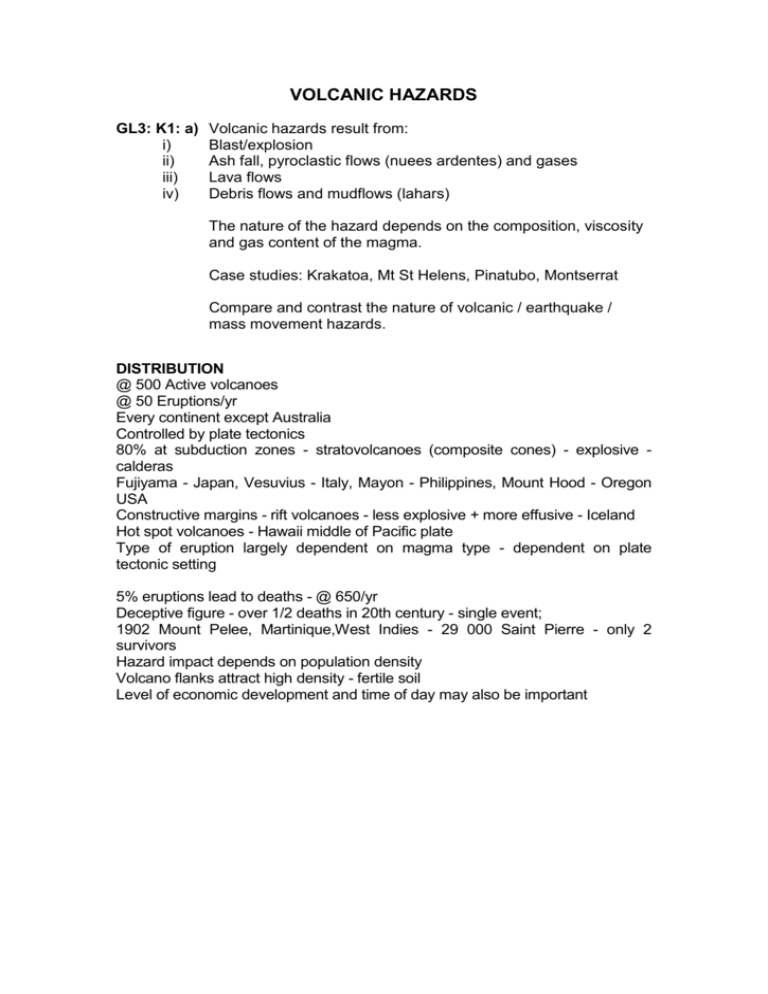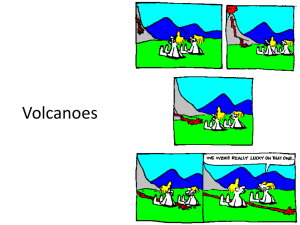VOLCANIC HAZARDS: INTRODUCTION
advertisement

VOLCANIC HAZARDS GL3: K1: a) i) ii) iii) iv) Volcanic hazards result from: Blast/explosion Ash fall, pyroclastic flows (nuees ardentes) and gases Lava flows Debris flows and mudflows (lahars) The nature of the hazard depends on the composition, viscosity and gas content of the magma. Case studies: Krakatoa, Mt St Helens, Pinatubo, Montserrat Compare and contrast the nature of volcanic / earthquake / mass movement hazards. DISTRIBUTION @ 500 Active volcanoes @ 50 Eruptions/yr Every continent except Australia Controlled by plate tectonics 80% at subduction zones - stratovolcanoes (composite cones) - explosive calderas Fujiyama - Japan, Vesuvius - Italy, Mayon - Philippines, Mount Hood - Oregon USA Constructive margins - rift volcanoes - less explosive + more effusive - Iceland Hot spot volcanoes - Hawaii middle of Pacific plate Type of eruption largely dependent on magma type - dependent on plate tectonic setting 5% eruptions lead to deaths - @ 650/yr Deceptive figure - over 1/2 deaths in 20th century - single event; 1902 Mount Pelee, Martinique,West Indies - 29 000 Saint Pierre - only 2 survivors Hazard impact depends on population density Volcano flanks attract high density - fertile soil Level of economic development and time of day may also be important PYROCLASTIC FLOWS Most deaths associated with explosive eruptions involving pyroclastic flows + tsunami Explosive eruptions - Nuee Ardente 'Glowing Cloud' Pompeii, Italy 79AD 16000 deaths Frothing of molten magma in vent; gas bubbles expand + burst explosively breaks lava Dense cloud of lava fragments ejected in turbulent mixture of hot gases + pyroclastics (Lava fragments, crystals, ash, pumice, glass shards) May be ejected vertically many 10's km into atmosphere Most flows rapidly down flank of volcano - dense Most hazardous if directed laterally by explosive blast - Pelean type Over 100km/hr May travel 30 -40km from source Hot - up to 1000 'C 70% deaths this century - asphyxiation + burning - damage to buildings + crops AIR-FALL TEPHRA Ashfall rarely kills - 1902 Guatemala 20cm ash collapsed roofs - 2000 deaths 1815 Tambora, Indonesia 1 400m of cone blasted off - 12km diameter caldera 12 000 deaths; further 80 000; disease + famine - crops destroyed by ash fall Fragmental material - Ash - less than 4mm + Lapilli - 4 - 32mm + Bombs - over 32mm Most less than 1 cubic km material - largest may be several x more Coarse deposited near vent Fine may be ejected high into atmosphere + windblown 00's km Ashfall may contain toxic chemicals - eg fluorine - contaminates soil + water Heavy ashfall destroys crops Light ashfall can be beneficial - fertilizer Heavy falls of coarser material - blanket + destroy crops eg 1963-5 Irazu volcano, Costa Rica; destroyed coffee crop: ruined farm land: $150m Flat roofed buildings collapse if thick ashfall Hot tephra may start fires LAVA FLOWS Effusive eruptions - molten lava + ash falls - greater threat to property - Hawaii Most hazardous to people if erupting rapidly from fissure eruptions Fluid basaltic magma on steep slopes 50km/hr Niyiragongo, Zaire 1977 - 5 fissure eruptions on volcano flanks - formed lake of lava - lake drained in under an hour - 40kmph - 72 deaths + over 400 houses destroyed Thick lava blankets sterilise farmland for many years Iceland 1783 24km fissure eruption 5 months - Lakagigar flow covered 560 square km - Few casualties - over 10 000 (22% population) died in resulting famine Unlikely to be repeated in modern world VOLCANIC GASES Water vapour, Hydrogen, Carbon Monoxide, Carbon Dioxide, Hydrogen Sulphide, Sulphur Dioxide, Sulphur Trioxide, Chlorine, Hydrogen Chloride Rarely direct cause of disaster Carbon Monoxide - toxic at very low concentrations - colourless, odourless 1.5x denser than air - accumulates in hollows - Death in 10-15 minutes 10% concentration - eg Java, Indonesia 1979 142 deaths - evacuees leaving volcano area walked into pool of gas and died immediately Carbon Dioxide - Lake Monoun, Cameroon 1984 37 deaths - Lake Nyos, Cameroon 1986 1746 deaths (less than 1% survived) + 8300 livestock - Deaths up to 23km away from crater - Very rare ? Accumulation from previous eruptions released by disturbance ? landslide LAHARS Volcanic mudflows - especially in wet tropics 2nd greatest hazard after pyroclastic surges Mudflows 10% deaths Kelut, Java, Indonesia 1919 5500 deaths Occur in association with seismic event + large quantities of water + steep volcano Water may originate from - violent electrical rainstorms triggered by eruption - Collapse of crater lake - Rapid melting of snow + ice; water mixes with ash Flows 50 - 80kmph Common hazard in Andes Cotopaxi, Ecuador 1877 - snowmelt - lahars 160km long Nevado del Ruiz, Columbia 1985 50km downstream lahar buried town of Armero 3-8m 22000 deaths LANDSLIDES Commonly associated with dacite magma - high viscosity + high dissolved gas Mount St Helens, USA 1980 Intrudes into mountain + causes cracking + bulging - earthquake triggered avalanches + landslides (2.7 cubic km rock) 57 deaths + property damage $1 billion TSUNAMIS Krakatoa, Indonesia 1883 Explosions heard 500km away - ash 80km up into atmosphere Cone collapsed into caldera Tsunami up to 30m - over 36000 drowned PREDICTING VOLCANIC ERUPTIONS GL3: K2: a) i) attempt A wide variety of monitoring techniques is used in an to predict hazardous geological events. Volcanoes. Indicators of underground movement include: i) Ground deformation ii) Gravity anomalies iii) Thermal anomalies iv) Gas emissions v) Seismic activity Case studies: Mt St Helens, Pinatubo Hazard maps Evaluation of degree of success of hazard prediction Only 10-20 volcanoes monitored well enough to allow scientific prediction Eg Mount St Helens USA 1980 - 57 deaths If no restrictions on access after warning ?1000 deaths Ground deformation - Swelling of cone + changes in ground slope near volcano; detected by tiltmeters, lasers, GPS Hydrothermal phenomena - Increased discharge from hot springs + fumaroles - Increased temperatures of water/steam/gas emissions - Increased temperature of crater lakes - Melting of snow + ice on volcano - Withering of vegetation on volcano slopes - Increased temperature can be detected by satellite thermal imaging cameras Chemical changes - Increase in Sulphur Dioxide, Hydrogen Sulphide from fumaroles Seismic activity - increase in local earthquake activity + audible rumblings - increase in size and frequency of long period events VOLCANIC HAZARD REDUCTION GL3: K2: c) The destructive effects of volcanoes can to some extent be managed and controlled in order to reduce risk. Volcanoes - Diversion of lava flows, control of lava speed and direction eg Etna No defence against pyroclastics - avoid flat roofs 20' slope minimum Lavas Bombing 1 High on volcano to spread lava + stop advancing lava flow 2 AA flows to breach levee like walls + spread out lava 3 Walls of cone at vent to spread flow - never tried eg Etna, Hawaii nb problems with poor visibility Artificial Barriers - only possible if favourable topography Only works for thin, fluid flows Walls 3m thick for each in depth of lava eg Etna 1983, Hawaii Water sprays - quite effective in Iceland 1973 Heimay - saved 400 buildings Hazard potential mapping - quite effective for Mt St Helens BENEFITS OF VOLCANIC ACTIVITY GL3: K2: d) Benefits are associated with some natural hazards: Volcanic activity- geothermal energy, fertile soils Geothermal power - Iceland, New Zealand, Italy Fertile soils - Indonesia Tourism Etna – Sicily Fujiyama – Japan Bromo - Java (Indonesia)






